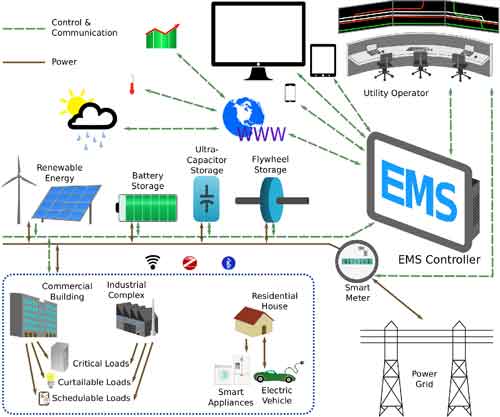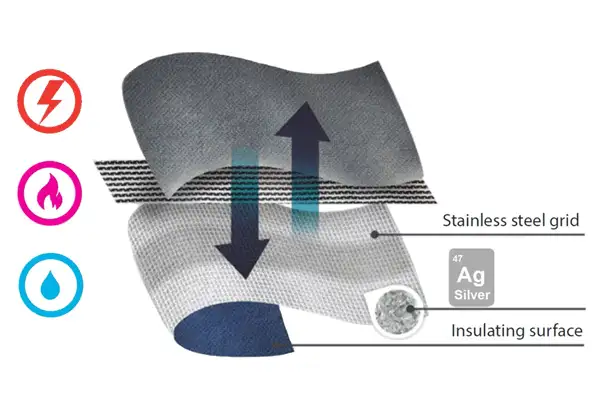Energy Management Systems & Smart Buildings
By R. W. Hurst, President, The Electricity Forum

Download Our OSHA 4475 Fact Sheet – Being Aware of Arc Flash Hazards

- Identify root causes of arc flash incidents and contributing conditions
- Apply prevention strategies including LOTO, PPE, and testing protocols
- Understand OSHA requirements for training and equipment maintenance
Energy Management Systems (EMS) enhance energy efficiency, reduce costs, and promote sustainability by monitoring, controlling, and analyzing energy use in buildings, enabling smarter resource allocation and a reduction in carbon footprint.
What are Energy Management Systems?
Energy Management Systems (EMS) are integrated platforms that monitor, control, and optimize energy consumption in facilities to enhance efficiency, promote sustainability, and achieve cost savings.
✅ Monitor and control energy use in real time
✅ Enhance efficiency, sustainability, and cost reduction
✅ Support compliance, reporting, and renewable integration
Energy management systems transform how we manage and consume electricity in industrial, commercial, and institutional power systems. By incorporating energy efficiency, building automation, smart grid technology, demand response, power monitoring, conservation, HVAC control, power optimization, renewable energy integration, and analytics, EMS offer a comprehensive EM for a more sustainable future.
By adopting Energy Management Systems, organizations can effectively manage consumption across their facilities, tracking energy usage in real-time to uncover opportunities for energy savings. This not only lowers operational costs but also reduces carbon emissions, supporting both financial performance and environmental responsibility.
Key Components of EMS
At the core of EMS systems are key components that work together to improve efficiency. These components include sensors, controllers, actuators, and communication networks that gather real-time data from various energy-consuming devices. This data is then analyzed to optimize the system's performance, ensuring cost-effective electricity use and minimal waste.
Energy Management Systems Overview
| Aspect | Description | Examples/Applications | Benefits |
|---|---|---|---|
| Core Components | Sensors, controllers, actuators, communication networks | Building systems, industrial plants | Real-time data, automation, optimized performance |
| Building Automation | Integrated control of lighting, HVAC, and equipment | Smart buildings, commercial facilities | Lower electricity use, cost savings, comfort, productivity |
| Smart Grid Integration | Linking EMS with utilities and renewable energy | Solar, wind, microgrids | Balanced supply-demand, grid reliability |
| Demand Response | Adjusting consumption in response to grid conditions | Industrial load shifting, peak demand control | Reduced costs, grid stability, incentives |
| Analytics & AI | Data analysis, predictive maintenance, optimization algorithms | Dashboards, machine learning models | Efficiency, reduced downtime, proactive management |
| Sustainability Focus | Incorporation of renewable energy and conservation strategies | Solar panels, wind turbines, green buildings | Reduced emissions, compliance, and carbon footprint cuts |
Building Automation and Efficiency
One of the primary ways energy management systems improve efficiency is through building automation. Building managers can monitor and control various aspects of their facility's electricity usage by integrating different systems such as lighting, heating, ventilation, and air conditioning (HVAC) control. This level of control enables them to make informed decisions, reducing power consumption while maintaining a comfortable and productive environment.
Sign Up for Electricity Forum’s Building Automation Newsletter
Stay informed with our FREE Building Automation Newsletter — get the latest news, breakthrough technologies, and expert insights, delivered straight to your inbox.
Smart Grids and Renewable Integration
Energy management systems also play a significant role in developing and implementing smart grids. These grids use advanced communication technologies and IoT devices to connect renewable energy sources, such as solar panels and wind turbines, with the electric utility. As a result, power supply and demand can be better balanced, leading to more efficient and reliable electricity distribution.
Demand Response and Conservation
Demand response is another crucial aspect of Energy Management Systems, allowing consumers to adjust their consumption based on real-time information from the electric grid. By participating in demand response programs, consumers can reduce their energy consumption during peak hours and benefit from lower costs.
Power conservation is a primary goal of energy management systems, which achieve this through various strategies, including efficient HVAC control, lighting optimization, and equipment scheduling. In addition, businesses and homeowners can significantly reduce their overall power usage by ensuring that power-consuming devices are used only when necessary.
Power optimization is a crucial aspect of EMS, achieved through the ongoing analysis of consumption patterns and equipment performance. Advanced power analytics tools can identify inefficiencies and recommend actions to maximize savings. These insights can help building managers create power-saving strategies, such as adjusting temperature set points, optimizing lighting controls, and scheduling equipment use.
One of the most exciting aspects of energy management systems is their seamless integration of renewable energy sources. By incorporating solar panels, wind turbines, and other clean power technologies, EMS can help businesses and homeowners reduce their reliance on fossil fuels and lower their carbon footprint.
The Role of IoT and AI
The role of IoT and AI in energy management systems is crucial, as they enable remote monitoring, real-time data analysis, and predictive maintenance. By utilizing IoT devices to collect data and AI algorithms to analyze it, EMS can identify inefficiencies and predict equipment failures, thereby ensuring optimal system performance.
By adopting EMS, businesses and homeowners can save money on their power bills and reduce their environmental impact. In addition, by optimizing power use, reducing waste, and integrating renewable energy sources, EMS leads to cost savings and contributes to the global effort to combat climate change.
Future Trends in EMS
The field of energy management systems is constantly evolving, with new trends and innovations emerging regularly. These innovations include integrating energy storage solutions, microgrids, and machine learning algorithms for even more precise power optimization.
Related Articles








